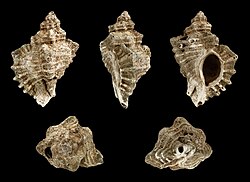
Back بوابة:علم الأحياء القديمة Arabic Portal:Paleontologia Catalan Portail:Paléontologie French Portale:Paleontologia Italian Portal:Paleontology Malay Portaal:Paleontologie Dutch Portal:Paleontologia Polish Portal:Paleontologia Portuguese Портал:Палеонтология Russian Портал:Палеонтология Tatar
|
The Palaeontology Portal
Introduction Paleontology (/ˌpeɪliɒnˈtɒlədʒi, ˌpæli-, -ən-/ PAY-lee-on-TOL-ə-jee, PAL-ee-, -ən-), also spelled palaeontology or palæontology, is the scientific study of the history of life in the geologic past. It includes the study of fossils to classify organisms and study their interactions with each other and their environments (their paleoecology). Paleontological observations have been documented as far back as the 5th century BC. The science became established in the 18th century as a result of Georges Cuvier's work on comparative anatomy, and developed rapidly in the 19th century. The term has been used since 1822 formed from Greek παλαιός ('palaios', "old, ancient"), ὄν ('on', (gen. 'ontos'), "being, creature"), and λόγος ('logos', "speech, thought, study"). Paleontology lies on the border between biology and geology, but it differs from archaeology in that it excludes the study of anatomically modern humans. It now uses techniques drawn from a wide range of sciences, including biochemistry, mathematics, and engineering. Use of all these techniques has enabled paleontologists to discover much of the evolutionary history of life, almost back to when Earth became capable of supporting life, nearly 4 billion years ago. As knowledge has increased, paleontology has developed specialised sub-divisions, some of which focus on different types of fossil organisms while others study ecology and environmental history, such as ancient climates. (Full article...) Selected article on the prehistoric world and its legacies
Stegosaurus (meaning 'roof-lizard') is a genus of stegosaurid armoured dinosaur from the Late Jurassic period (Kimmeridgian to Early Tithonian) in what is now western North America. However, in 2006 a specimen of Stegosaurus was announced from Portugal, suggesting that they were present in Europe as well. Due to its distinctive tail spikes and plates, Stegosaurus is one of the most recognisable dinosaurs, along with Tyrannosaurus, Triceratops and Apatosaurus. At least three species have been identified in the upper Morrison Formation and are known from the remains of about 80 individuals. They lived some 155 to 145 million years ago, in an environment and time dominated by the giant sauropods Diplodocus, Camarasaurus and Apatosaurus.
A large, heavily built and herbivorous quadruped, Stegosaurus had a distinctive and unusual posture, with a heavily arched back, short forelimbs, head held low to the ground and a stiffened tail held high in the air. Its array of plates and spikes have been the subject of much speculation. The spikes were most likely used for defence, while the plates have also been proposed as a defensive mechanism, as well as having display and thermoregulatory (heat control) functions. Stegosaurus was the largest of all the stegosaurians (bigger than genera such as Kentrosaurus and Huayangosaurus) and, although roughly bus-sized, it nonetheless shared many anatomical features (including the tail spines and plates) with the other stegosaurian genera. (see more...) Did you know?

General images -The following are images from various paleontology-related articles on Wikipedia.
Selected article on paleontology in human science, culture and economics
There have been a number of potential species assigned to the carnosaurian dinosaur genus Allosaurus since its description in 1877 by Othniel Charles Marsh, but only a handful are still regarded as valid. Allosaurus was originally described from material from the Upper Jurassic Morrison Formation of the western United States of America; the type species A. fragilis became one of the best-known species of dinosaur.
The genus Allosaurus was part of the Marsh/Cope "Bone Wars" of the late 19th century, and its taxonomy became increasingly confused due to the competition, with several genera and species named by Cope and Marsh now regarded as synonyms of Allosaurus or A. fragilis. Since the description of Allosaurus, scientists have proposed additional species from such far-flung locales as Portugal, Siberia, Switzerland, and Tanzania, and unnamed remains from Australia and China have also been assigned to the genus at one time or another. (see more...) On this day...
Selected image
CategoriesTopicsGeneral - Paleontology - Fossil - Evolution - Extinction Quality ContentFeatured paleontology articles
- Achelousaurus
- Acrocanthosaurus
- Albertosaurus
- Allosaurus
- Amargasaurus
- Ankylosaurus
- Apatosaurus
- Archaeopteryx
- Baryonyx
- Carnotaurus
- Catopsbaatar
- Ceratosaurus
- Chicxulub Crater
- Compsognathus
- Cretaceous–Tertiary extinction event
- Daspletosaurus
- Deinocheirus
- Deinonychus
- Deinosuchus
- Dilophosaurus
- Dinosaur
- Diplodocus
- Dromaeosauroides
- Edmontosaurus
- Elasmosaurus
- Giganotosaurus
- Gorgosaurus
- Herrerasaurus
- Iguanodon
- Istiodactylus
- Lambeosaurus
- List of dinosaur genera
- Majungasaurus
- Massospondylus
- Megalodon
- Nemegtomaia
- Nigersaurus
- Opisthocoelicaudia
- Paranthodon
- Parasaurolophus
- Plateosaurus
- Psittacosaurus
- Seorsumuscardinus
- Spinosaurus
- Stegosaurus
- Stegoceras
- Styracosaurus
- Tarbosaurus
- Thescelosaurus
- Triceratops
- Tyrannosaurus
- Velociraptor
Things you can doCurrent Paleontology FACs - None yet... WikiProjectsRelated portalsAssociated WikimediaThe following Wikimedia Foundation sister projects provide more on this subject:
Discover Wikipedia using portals |








































